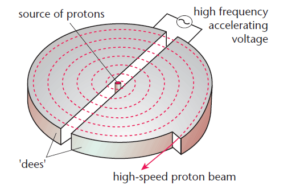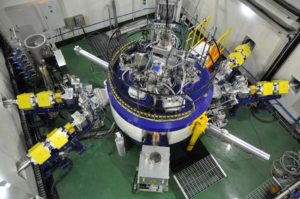Science > Physics > Magnetic Effect of Electric Current > Cyclotron
The device which uses the electric or magnetic field to guide and accelerate a beam of charged particles to high speed is called a particle accelerator. Charged particles used may be protons or electrons. These high-velocity particles are used in nuclear physics and high energy physics. Depending upon the direction of motion of charged particles, they have classified into two types a) Linear accelerator and b) Circular accelerator or Cyclotron.
In linear accelerator charged particles move in a straight line. To achieve velocity in kilometres, the length of linear accelerators is also in kilometres, thus the length of linear accelerators is very large. In Cyclotron the same distance as in linear accelerators is covered in concentric circles. Hence the size of the cyclotron is greatly reduced. The first cyclotron was developed by Lawrence and Livingston in 1931 at the University of California.
Cyclotron:
Principle:
An electric field can accelerate a charged particle and the magnetic field can throw the particle in a circular orbit such that its frequency of the revolution does not depend on its speed. Thus the radius of circular path increases, the speed of the particles goes on increasing.
Diagram:


Construction:
It consists of a pair of hollow metal chambers labelled D1 and D2 which are flat and semicircular in the shape of the letter ‘D’ back to back. Hence these chambers are called ‘Dees’. A source of a charged particle is located at the midpoint of the gap between the two dees.
The dees are connected to the radio frequency oscillator to apply high frequency between the dees. Dees act as electrodes and the potential between the two dees is made to alter very rapidly. The dees are then fixed in a large metal box which is evacuated. The whole apparatus is put between a strong electromagnet which makes the particle to move in a circular path.
Working:
Let us assume a positive charge particle (proton) having a charge ‘q’ is emitted from the source. Let us assume at this instant D1 is negative. It is accelerated towards D1. Let v1 be the velocity of the particle when it reaches D1. Due to the magnetic field of induction, it starts moving in a circular path in D1. Let r1 be the radius of the circular path and ‘m’ be the mass of the charged particles.

After completing the semicircular path, the particle reaches gap again. At this instant, D2 is made negative. Let v2 be the velocity of the particle when it reaches D2. Due to the magnetic field of induction, it starts moving in a circular path in D2. Let r2 be the radius of the circular path.

Dividing equation (1) by (2) we get

Thus the angular velocity and hence the period is constant or it is independent of the velocity of the particle. Thus at every crossing of the gap the velocity of the charged particle increases. It traces a flat spiral of increasing radius. Then at the periphery point, it is deflected on target with very high velocity using a deflecting plate.
Uses:
- The fast-moving charged particles obtained using cyclotron can be used in artificial transmutation.
- The fast-moving charged particles obtained using cyclotron can be further used to obtain high energy fast-moving particles like neutrons, which can be used in nuclear fission.
- The fast-moving charged particles obtained using cyclotron can be used in inducing artificial radioactivity.
Previous Topic: Tangent Galvanometer